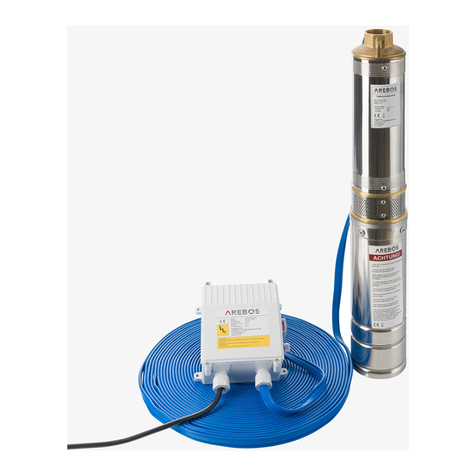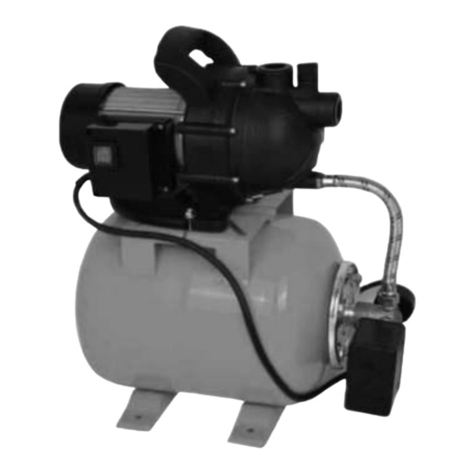
User’s Manual –AREBOS Domestic waterworks 1200 W
13
8.Cleaning, maintenance and storage
•Under normal conditions, the water pump is maintenance-free.
•Before carrying out any work on the device, remove the mains plug from the socket.
•If the power cord is damaged, it must be replaced by a qualified electrician. Short-circuit
damage is not covered by the warranty.
•Check the pre-charge pressure in the boiler every 2-3 months or when the pump starts after
a small water intake.
8.1 General cleaning work
•Clean and maintain your device regularly. This ensures its performance and long life.
•From time to time, clean the chambers by rinsing them with clean water to prevent them
becoming blocked by dirt.
•After pumping raw water or rainwater or other fluids, flush the pump with clean water.
When using a suction filter (recommended!), clean it regularly.
•Clean the controls with a dry cloth.
•Never spray the device with water or immerse it in water.
•Never use solvents such as gasoline, alcohol, ammonia water, etc. These solvents can
damage the plastic parts.
8.2 Clean check valve
•Removing and installing filter.
•Unscrew check valve and clean under running water.
•Renew gasket if necessary.
•Install check valve.
8.3 Eliminate blockages
•If you pump contaminated fluids without an aspiration filter (pre-filter) - despite explicit
reference not to do so - the device may become clogged.
•Remove the suction hose at the pump inlet.
•Connect the pressure hose to the water pipe.
•Rinse the pump and, if necessary, clean the suction filter.
•Check by briefly switching on, if the pump turns free.
•If you cannot eliminate the blockage, the pump parts must be disassembled and cleaned. Be
sure to have this work done by an authorized specialist.
8.4 Increase the pre-charge pressure
•If the air pre-charge pressure in the boiler is too low, the pump will restart much faster and
damage to the equipment may occur. Therefore, check the pre-charge pressure regularly.
The pre-charge pressure cannot be read off on the pressure gauge!
•Unplug the power plug.
•Open the pressure line (taps, nozzles, etc.) and allow the water to drain completely.
•Unscrew the plastic cap on the boiler, behind it is the air valve
•Place an air pump with pressure gauge on the air valve.
•Check the pre-charge pressure.
•If necessary, pump air into the boiler.
•Screw the plastic cap onto the boiler, connect the device and fill it.
•Additional measures, in particular the opening of the pump, must be carried out by a
qualified electrician. In case of repair, always contact a service workshop.




































